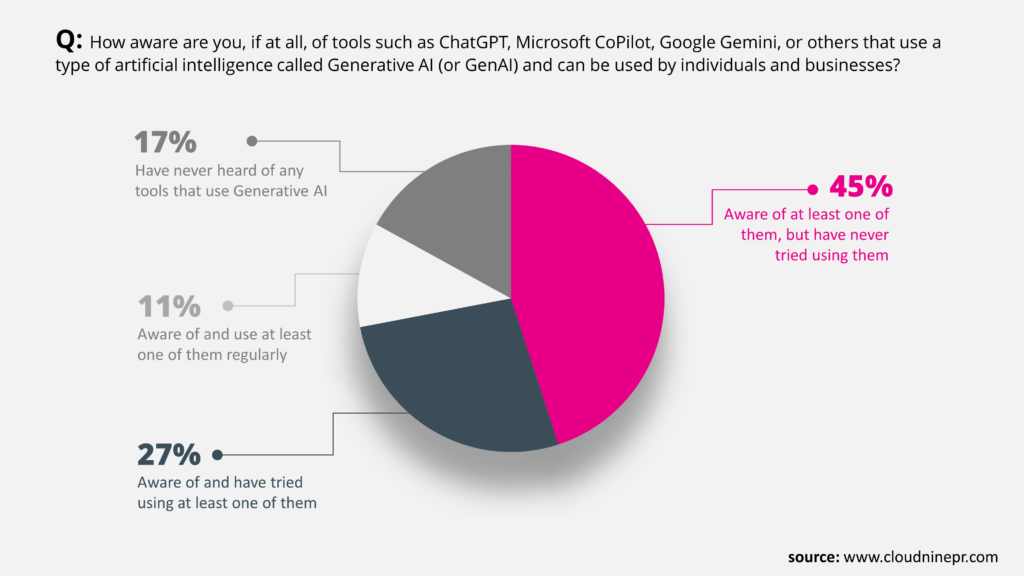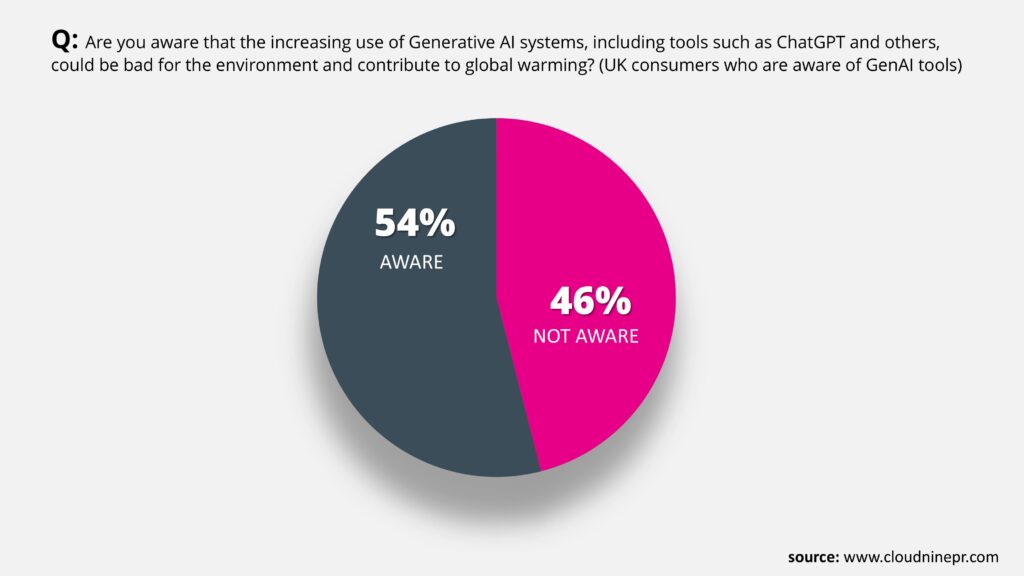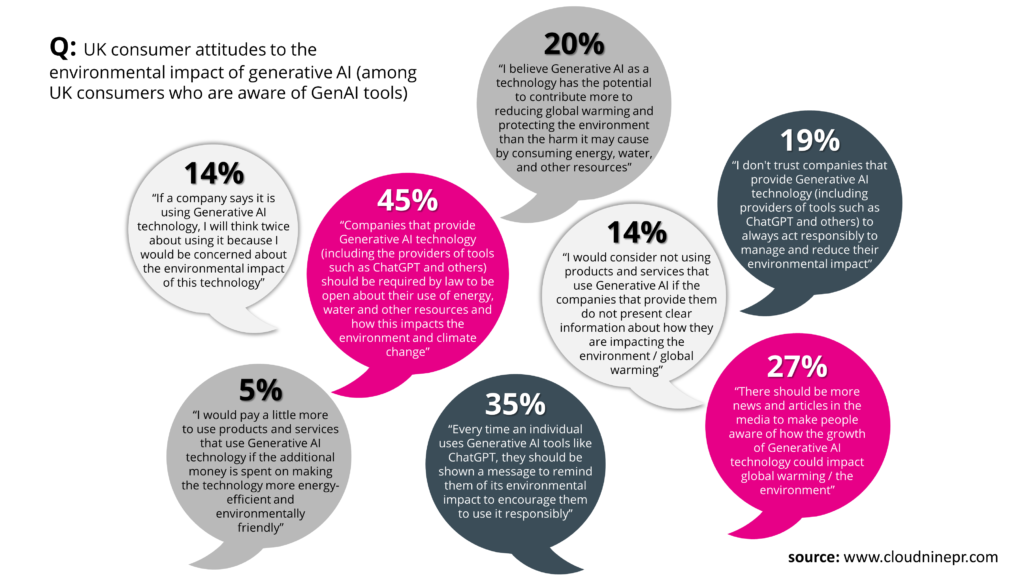When ChatGPT first hit the headlines in 2022, very little was said about GenAI’s environmental cost—and the AI companies have mostly kept the full extent of their impact a “closely guarded corporate secret”. Now, this issue is in the media spotlight, with growing awareness about the environmental risks associated with GenAI’s widespread adoption.
A UK poll I commissioned for CloudNine PR reveals that:
54% of people who are familiar with GenAI now know that its expansion is likely to be damaging to the planet.
45% want laws that force GenAI companies to be transparent about their environmental costs.
One out of five don’t trust companies like Open AI to act responsibly to manage and reduce their environmental impact.
10% of regular GenAI users will pay a little more for greener tools.
Generative AI is highly energy-intensive. While the data centres that power GenAI tools continue to burn fossil fuels, concerns are growing about their impact on the environment. The rapid expansion of GenAI could pose a significant challenge in the fight against climate change.
The survey of 1,000 UK adults was conducted in August to assess the public’s awareness of GenAI and the damage it could do to the planet. Read on for more details.
Key findings
An overwhelming 83% of Brits are now aware of generative AI (including 27% who have tried using at least one GenAI tool and 11% who now use at least one tool regularly).

54% of people who are aware of GenAI know that its expansion could harm the environment and contribute to global warming.

Digging further into the attitudes of people who are familiar with Generative AI, the research suggests that:
- 45% want laws that require companies to be transparent about the environmental and climate change impact of their GenAI systems.
- More than a third (35%) agree that Generative AI tools such as ChatGPT should remind users about their environmental impact each time they use them to encourage responsible usage.
- 27% believe there should be more news and articles in the media to make people aware of how the growth of Generative AI technology could impact global warming / the environment.
- 5% would pay a little more to use products and services that use Generative AI technology if the additional money was spent on making the technology more energy-efficient and environmentally friendly (this rises to 10% among regular users of GenAI tools).
- 19% don’t trust companies that provide Generative AI technology (including providers of tools such as ChatGPT and others) to always act responsibly to manage and reduce their environmental impact.

The following is a snapshot of some of the main issues and research on the debate about GenAI and climate change.
GenAI’s Energy Dilemma: 5 Key Insights on the Climate Challenge
1) GenAI and its hunger for electricity
Generative AI systems consume electricity by drawing on the computational power in thousands of computer servers housed in the data centres supporting their operations.
- The International Energy Agency (IEA) has estimated that each time a GenAI tool or application processes a user prompt or completes a task (a process known as inference) it consumes about 10x more electricity than a simple Google search. If the 9 billion Google searches that are performed every day were replaced with GenAI queries (such as ChatGPT requests) the electricity demand would increase by an amount similar to the annual consumption of around 1.5 million European Union residents.
- Training the large language models (LLMs) that GenAI systems use is also very power intensive, consuming significantly more electricity than many other data center activities. It’s estimated that training a model such as GPT-3 uses about as much electricity as 130 US homes annually (just under 1,300 megawatt hours (MWh)). And with LLMs increasing in size, training newer models is likely to use even more energy.
2) AI data centre energy demand and its impact on big tech’s environmental goals
- The IEA estimates that the electricity consumption from data centres, AI and the cryptocurrency sector could double by 2026, roughly equivalent to Japan’s electricity consumption.
- Research by Morgan Stanley indicates that power demand from generative AI will increase at an annual average of 70% through to 2027, mostly due to the growth of data centre capacity to support it. By 2027, generative AI could use as much energy as Spain needed to power itself in 2022, the data suggests.
- The big technology companies’ commitment to AI is making it harder for them to meet their climate change targets. Microsoft’s greenhouse gas emissions were around 30% higher in 2023 as it tried to meet climate goals while trying to lead in AI. Similarly, Google’s 2024 Environmental Report shows a 13% rise in emissions from AI & data centre energy consumption.
- Earlier this year OpenAI’s CEO, Sam Altman, is quoted as saying, “an energy breakthrough is necessary for future artificial intelligence, which will consume vastly more power than people have expected.”
3) How can we make AI and GenAI greener?
The major hope for counteracting climate change is that the world can switch from fossil fuels to renewable and cleaner energy sources. And many big tech brands are taking it upon themselves to invest in these areas to drive their AI expansion.
- The WSJ has reported that “The owners of roughly a third of US nuclear power plants are in talks with tech companies to provide electricity to new data centers needed to meet the demands of an artificial intelligence boom”.
- To help it meet its climate targets while growing its AI products and services, Microsoft announced a $10 billion deal with asset manager Brookfield to supply it with 10.5 gigawatts of renewable power capacity between 2026 and 2030. This is the biggest ever deal like this, roughly equating to the electricity consumed by 4 million homes.
- Another example is Facebook owner Meta, which recently agreed a significant deal to buy geothermal power for its U.S. data centers as it expands its AI infrastructure. Geothermal power is a renewable energy source that uses the Earth’s internal heat to produce electricity and heat water.
Along with switching to cleaner and renewable energy, experts advise that companies try to reduce AI’s carbon footprint by investing in energy-efficient servers and storage devices and using environmentally friendly data centre cooling methods.
Using smaller, more efficient LLMs in cases when IT applications don’t strictly need the bigger, more energy-intensive models to perform satisfactorily can also help.
4) Increasing transparency around AI power usage and emissions
An important part of the solution is creating greater transparency around the energy consumption and the carbon footprint of individual GenAI and AI providers and applications.
- Leading technology firms such as Salesforce are supporting the introduction of legislation requiring companies to use standardised measurements for reporting the carbon emissions and environmental impact of AI systems.
- In February, US Democratic lawmakers introduced the Artificial Intelligence Environmental Impacts Act of 2024, a bill aimed at developing standards to measure and report the full range of AI’s effects on the environment, as well as creating voluntary processes for AI developers to report the impacts.
Clearer reporting and benchmarking of AI technologies’ carbon footprints would allow customers to make informed decisions about which providers and companies they should do business with. This would further incentivise the sector to become greener and more environmentally friendly.
5) Can GenAI help rather than hinder the fight against climate change?
The other side of the story is that many experts believe Generative AI can actively help the world reduce carbon emissions. Microsoft co-founder Bill Gates has claimed that AI would help countries use less energy by making technology and electricity grids more efficient, for example.
Generative AI is starting to be used in climate tech applications in numerous ways. It is helping to optimise supply chains to cut product waste and excess greenhouse gas emissions, for example, and to minimise energy consumption and emissions in commercial buildings by sending real-time optimised control commands to the buildings’ HVAC (heating, ventilation, and air conditioning) systems.
Conclusion: What does all this mean for the AI and Gen AI sector?
The rapid growth of GenAI brings significant challenges, particularly with regards to how it impacts global net zero goals. And now the general public is starting to become more aware of this. However, by transitioning to renewable energy, adopting more energy-efficient technologies, providing transparent reporting on carbon footprints and focusing on AI’s potential to combat climate change, the major players in the AI sector can help address these concerns.
Companies that are building and using AI and GenAI systems, including the many startups emerging in the sector, will have to understand and address the environmental consequences of their operations.
With 45% of consumers who are familiar with GenAI calling for laws that mandate transparency about the environmental footprint of GenAI systems, the pressure is mounting—not only from consumers but also, potentially, from regulators.
As AI companies build and scale, they will need to demonstrate responsibility, not just in terms of data ethics but also environmental sustainability. This includes investing in greener infrastructure, partnering with renewable energy sources and optimising their AI models or using smaller models that consume less energy. Sustainability is likely to become an important differentiator going forward.
About the survey
Cloudnine PR commissioned market research company Censuswide to conduct a survey of a nationally representative sample of 1,000 UK consumers to assess their awareness of Generative AI and its impact on the environment. The data was collected between 20th and 23rd August, 2024. Censuswide abides by and employs members of the Market Research Society and follows the MRS code of conduct and ESOMAR principles. Censuswide is also a member of the British Polling Council.